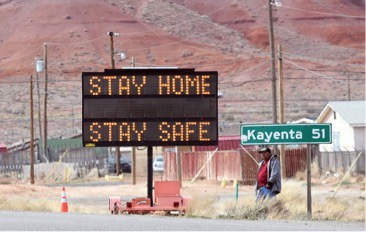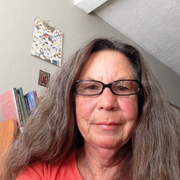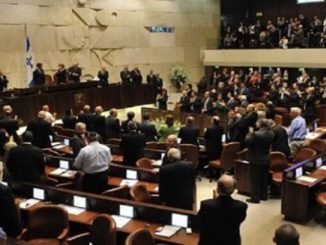
By Benay Blend
In News for All the People: The Epic Story of Race and the American Media, Juan Gonzales and Joseph Torres reveal how racial segregation helped distort the information that Americans read in the mainstream media. Today, similar distortions, for different reasons, continue to mark mainstream media’s reporting.
In the very early days of “social distancing,” New Mexico Gov. Michelle Lujan Grisham informed President Donald Trump regarding “incredible spikes” of COVID-19 in the Navajo Nation, a problem that she felt required more “testing and surveillance” to bring it under control. Without those measures, Grisham feared, the virus could quite possibly “wipe out” tribal nations, including those here in New Mexico.
Reportage of this initial exchange included several tropes that have a long history in the ways that Indigenous issues are covered. Significantly, there is no mention of “institutional racism and colonialism,” two aspects, writes Rebecca Miles, Executive Director of the Nez Perce tribe, that inform health disparities not only among Native American tribes but Palestinian people, too.
The high number of cases on the Navajo Nation is “ shedding light on the disparities that have already existed,” explains Navajo Council Delegate Amber Crotty, “and also the lack of federal funding to meet the demand of the health needs.” Moreover, adds Navajo activist Emma Robbins, those in homes without running water find it difficult to wash their hands.
In fact, the Navajo Nation suffers some of the highest rates of water poverty in the United States. In order to access necessities, such as bottled water and soap, families have to travel to different grocery stores, only to find that when they arrive those items are sold out. Whether people go out to haul water from stores or watering points, they run the risk of exposing themselves to others.
Without adequate health facilities across the reservation, even those who do have access live far away, so don’t get there in a timely matter for treatment. In this case, testing and surveillance (whatever that implies), two priorities listed by Gov. Lujan-Grisham, might prove useful in the short run to curb the outbreak of the virus. However, it does not address the overarching issue highlighted in an article by the Editor of the Red Nation, namely that “capitalism has proven biologically unsuitable for life.”
As reported by Amy Goodman on Democracy Now:
“Navajo Nation, which stretches some 27,000 square miles across portions of Arizona, New Mexico and Utah, has been the hardest hit by the virus so far, with more than 830 reported cases and 28 deaths as of Tuesday. In Arizona, 16% of COVID-19 deaths have been Native Americans, who make up only 6% of the state’s population. Meanwhile, two pueblos in New Mexico, Zia Pueblo and San Felipe, have some of the highest rates of infection in the United States.”
Failure on the part of mainstream media to note why the virus has disproportionately impacted the Navajo Nation echoes most coverage of the Palestinian / Israeli “conflict.” For example, as Ali Abunimah notes, prominent reporters invariably refer to “clashes” in circumstances where there are a disproportionate number of Palestinian casualties.
Moreover, just as handling of the Navajo Nation focuses on the current situation, with no mention of 500 years of colonization, analysis of the May 2018 slaughter of Palestinians lacked any reference to the Nakba, the 1948 ethnic cleansing of Palestine before and after the State of Israel was founded.
Syntax and word choice also shape, and perhaps mislead, representations of how the Coronavirus has impacted Indigenous groups of people. Writing for CNN, John Blake proposes that “Native Americans are particularly susceptible to the coronavirus because they suffer from disproportionate rates of asthma, heart disease, hypertension and diabetes.” No mention of over 500 years of colonization that has led to those diseases, but rather the author implies that the problems are somehow endemic to the people.
To his credit, Blake goes on to quote Indigenous scholar Roxanne Dunbar-Ortiz, who explains that Native Americans never “just dropped dead” from earlier epidemics that decimated Native people. They would not have been “so vulnerable” (substitute susceptible) she says, “if white settlers were not trying to literally wipe them out.” Finally, she claims that “physical and psychological assault depressed native peoples’ immune systems,” a reality that perhaps explains health disparities in Indian Country today.
“That’s actually a narrative created to not deal with the fact of genocide,” Dunbar-Ortiz concludes, referring to the way that commentators obscure the impact of colonialist policies on Native peoples’ lives. “You say it was no one’s fault because the only reason they succumbed had nothing to do with war or colonization.” Even when the facts are actually stated, the ways in which sentences are constructed, and the extent to which those facts are not placed within a historical context, might lead readers to think that no one is actually to blame.
In a New York Times article covering the Coronavirus in Palestine, Mohammed Najib and David M. Halbfinger refer to “tensions between age-old antagonists,” implying that both sides are equally responsible for Palestinian casualties during a “conflict” that actually has gone on forever. Rather than mentioning the Nakba, the authors’ talking points are ahistorical, thereby misleading the reader to believe that such “conflicts” date back to a mythical (perhaps biblical?) past. Moreover, instead of “cooperation” over containing the Coronavirus that the authors falsely state has been the hallmark of Israeli / Palestinian dealings, Najib and Halbfinger fear that the added stress might result in Palestinians “ratcheting up rhetoric,” thus blaming the victims in this case for Israel’s refusal to care for its occupied population.
Finally, Governor Lujan Grisham’s warning that the tribes could be “wiped out” by the virus appeared well-meaning, but again played on an old trope of “the vanishing Indian” that goes back to the turn of the 20th Century. At a time when Native populations were in fact increasing, Americans began to feel nostalgia for the West that they believed was gone. As part of that history, Native people were mythologized as noble warriors of a long-gone, ahistorical past, a people destined for extinction.
Both Palestinians and Native Americans have been subjected to genocidal settler-colonial regimes; nevertheless, partly because of their resiliency, neither are extinct, as the myth would have us think. As Steven Salaita observes, that assumption persists in the belief that “Natives have been permanently dispossessed or exist as ahistorical monuments of conquest unable to access modernity, if they exist at all.” Because of this notion, Salaita warns, Palestinian activists might be tempted to use Natives as a model for a “tragic fate” that they do not want themselves. However well-intentioned, as Lujan-Grisham seemed, her statement reinforces what Salaita calls “an ongoing colonial erasure of Indigenous people” both within our borders and beyond.
For good reason, then, some journalists repeat the “vanishing Indian” myth, for erasure in the past means that Natives voices do not exist today; nor do they have a say in their future. Nevertheless, as Salaita claims, tribal people representing hundreds of discrete nations currently fight for “restitution, sovereignty, treaty rights, self-determination and liberation.” Despite setbacks that will inevitably occur during this time of crisis, both Native Americans, and their relatives, the Palestinians, pose excellent examples of what Salaita terms “principled and innovative forms of decolonization.”
For example, Emma Robbins describes below how the Navajo Nation employs Indigenous Mutual Aid:
“I think I’ve seen many Navajo women step up and fight for our communities, which is our traditional role. That’s not to say that we’re in the ’60s and it’s the idea of stay in the kitchen. It’s that we are the caretakers of our communities. And this is nothing new for us. It’s time to step up and work together and just make it happen, where people are able to get the help that they need and to really just come back and serve our communities. I think of this as by Navajos, for Navajos, of projects that are happening on the reservation successfully.”
“We are a sovereign nation,” Robbins states. “Yes, we are able to help ourselves.” But she also stresses the importance of honoring past treaties which provide funding from the federal government, especially now, when the tribe needs help. “Right now we can’t wait,” she concludes.
Just as Gonzales and Torres put race at the center of their story, if more journalists followed that example by inviting Palestinians and Native people to tell first-hand their stories, pertinent information that is scattered throughout independent media would be mainstream. Disregarding the impact of racist policies does very little to “flatten the curve,” but instead continues the practice of blaming the victims for their plight.
– Benay Blend earned her doctorate in American Studies from the University of New Mexico. Her scholarly works include Douglas Vakoch and Sam Mickey, Eds. (2017), “’Neither Homeland Nor Exile are Words’: ‘Situated Knowledge’ in the Works of Palestinian and Native American Writers”. She contributed this article to The Palestine Chronicle.

– Benay Blend earned her doctorate in American Studies from the University of New Mexico. Her scholarly works include Douglas Vakoch and Sam Mickey, Eds. (2017), “’Neither Homeland Nor Exile are Words’: ‘Situated Knowledge’ in the Works of Palestinian and Native American Writers”. She contributed this article to The Palestine Chronicle.







